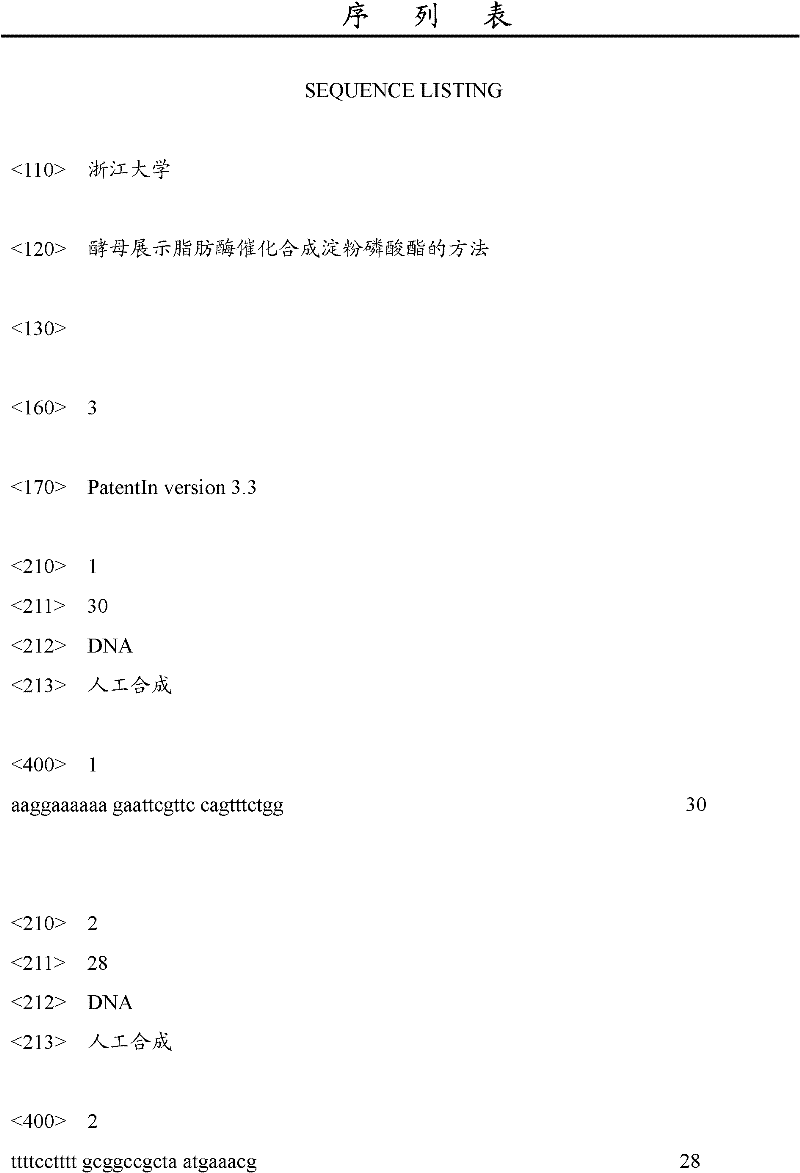Method for catalytic synthesis of starch phosphate by utilizing yeast display lipase
A starch phosphate and lipase technology, applied in the field of bioengineering, can solve the problems of complicated and time-consuming immobilization process, limited commercial application and high production cost, and achieve the effects of improving operational stability, shortening reaction time and low production cost.
- Summary
- Abstract
- Description
- Claims
- Application Information
AI Technical Summary
Problems solved by technology
Method used
Image
Examples
Embodiment 1
[0018] Example 1 Preparation of Yeast Displaying Lipase
[0019] Synthesize the lipase gene (Genbank number: AF229435) of Rhizopus oryzae and the cell wall α-lectin gene of Pichia pastoris GS115 (Genbank number: M28164) by artificial synthesis, and add Connect the peptide sequence GSSGGSGGSGGSGGSGS(linker), and get the nucleotide sequence pro-ROL-linker-α-agglutinin after connection, and add EcoR I and Not I restriction sites at both ends of the sequence, where pro-ROL is the lipase gene , α-agglutinin is the cell wall α lectin gene.
[0020] Using the above artificially synthesized sequence as a template, PCR amplification was performed using the following primer pair,
[0021] Upstream primer: 5'-AAGGAAAAAAAGAATTCGTTCCAGTTTCTGG-3';
[0022] Downstream primer: 5'-TTTTCCTTTTGCGGCCGCTAATGAAACG-3'
[0023] The PCR reaction system is: 1 μl of template DNA, 0.5 μl of high-fidelity DNA polymerase, 0.4 μl of dNTP (50 mM), 0.5 μl of upstream and downstream primers, 5 μl of 10×PCR ...
Embodiment 2
[0027] Example 2 Yeast shows lipase catalyzed synthesis of starch phosphate
example 1
[0028] Example 1 Take 350g corn starch and prepare 35% starch milk (starch dry base) with water, absorb water at 65°C for 15min to make the starch milk absorb water and swell, add 1g of the above-mentioned prepared yeast to display lipase after cooling, and then add 10g NaH in batches 2 PO 4 , placed in a 85-1 type magnetic stirrer and stirred to start the reaction, the rotation speed was 200 rpm, the reaction temperature was kept at 60°C, the stirring was stopped after 1 hour of reaction, the pH value was adjusted to 7.0, the starch phosphate was precipitated by ethanol, and washed , suction filtration, vacuum drying, and the resulting powder is the finished product.
PUM
 Login to View More
Login to View More Abstract
Description
Claims
Application Information
 Login to View More
Login to View More - R&D
- Intellectual Property
- Life Sciences
- Materials
- Tech Scout
- Unparalleled Data Quality
- Higher Quality Content
- 60% Fewer Hallucinations
Browse by: Latest US Patents, China's latest patents, Technical Efficacy Thesaurus, Application Domain, Technology Topic, Popular Technical Reports.
© 2025 PatSnap. All rights reserved.Legal|Privacy policy|Modern Slavery Act Transparency Statement|Sitemap|About US| Contact US: help@patsnap.com


